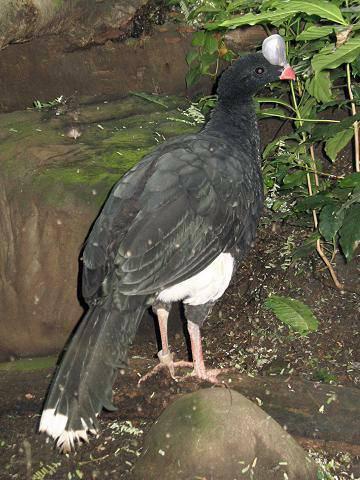- Northern Helmeted Curassow
Taxobox
name = Northern Helmeted Curassow

image_width = 200px
image_caption = Probably Mérida Helmeted Curassow, "Pauxi pauxi pauxi"
status = EN
status_system = iucn3.1
regnum =Animal ia
phylum =Chordata
classis =Aves
ordo =Galliformes
familia =Cracidae
genus = "Pauxi "
species = "P. pauxi"
binomial = "Pauxi pauxi"
binomial_authority = Linnaeus,1766
subdivision_ranks =Subspecies
subdivision ="Pauxi pauxi gilliardi" Wetmore & Phelps,1943
"Pauxi pauxi pauxi" Linnaeus, 1766The Northern Helmeted Curassow, "Pauxi pauxi" is a large (up to 91cm long) terrestrial black
curassow with a small head, large bluish grey casque on forehead, red bill, white-tipped tail feathers, greenish glossed mantle and breast feathers, and white below. Both sexes are similar. The male, at 3.6 kg (8 lbs), is larger than the female, at 2.6 kg (5.8 lbs). Some rare rufous morph female has a black barred and reddish brown plumage. For some time, it also contained theSouthern Helmeted Curassow taxa assubspecies and was simply known as the Helmeted Curassow. Nowadays its southerncongener is considered a distinct species "P. unicornis".There are 2
subspecies :
* Mérida Helmeted Curassow, "Pauxi pauxi pauxi":Cordillera de Mérida intoCordillera Oriental, Colombia :Casque larger, egg-shaped
* Perijá Helmeted Curassow, "Pauxi pauxi gilliardi":Serrania del Perija :Casque smaller, less bulbous, rather cylindrical in shape.Their
evolution ary history is not well researched compared to other curassows. The helmeted curassows probably are a lineage of LateMiocene (Tortonian -Messinian , about 8-7 million years ago) origin. This species' present-day distribution suggests that it became isolated some 6 million years ago as its mountain range uplifted [Pereira & Baker (2004)] . It is not known whengene flow between the subspecies ceased.One of the largest birds in its
habitat , the Helmeted Curassow is distributed in the easternAndes ofVenezuela andColombia . The diet consists mainly of seeds, fruits, insects and small animals. The female lays two cream colored eggs and incubates it for about 30 days.The Helmeted Curassow is listed on Appendix II of
CITES . Formerly classified as anVulnerable species by theIUCN [BLI (2004)] , recent research shows that its numbers are decreasing more and more rapidly. It is consequently uplisted toEndangered status in 2008 [BLI (2008)] .Footnotes
References
*|year=2004|id=46899|title=Pauxi pauxi|downloaded=1 November 2006
* (2008): [http://www.birdlife.org/action/science/species/global_species_programme/whats_new.html [2008 IUCN Redlist status changes] . Retrieved 2008-MAY-23.
* (2004): Vicariant speciation of curassows (Aves, Cracidae): a hypothesis based on mitochondrial DNA phylogeny. "Auk" 121(3): 682-694. [English with Spanish abstract] DOI:10.1642/0004-8038(2004)121 [0682:VSOCAC] 2.0.CO;2 [http://www.bioone.org/perlserv/?request=get-abstract&doi=10.1642%2F0004-8038%282004%29121%5B0682%3AVSOCAC%5D2.0.CO%3B2 HTML abstract] [http://findarticles.com/p/articles/mi_qa3793/is_200407/ai_n9456682 HTML fulltext without images]External links
* ARKive - [http://www.arkive.org/species/GES/birds/Pauxi_pauxi/ images and movies of the Helmeted Curassow "(Pauxi pauxi)"]
* [http://www.birdlife.org/datazone/species/index.html?action=SpcHTMDetails.asp&sid=101&m=0 BirdLife Species Factsheet]
Wikimedia Foundation. 2010.
